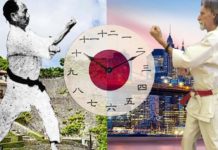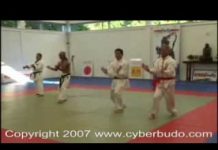“The kata are the essence of karate; without them karate would be the mere learning of various fighting and self-defense techniques, expressing nothing and allowing for no aesthetic development. Kata are the distilled, concentrated wisdom, understanding and experience of hundreds of great karate masters, translated into a language of rhythmical movement, breathing, and peak awareness. When one begins to understand them, one glimpses a new world of untold internal riches. We come out of the dance, so to speak.” ~ Peter Urban – The Karate Dojo
By Professor Rick Clark ~ Sometimes defined as a set pattern of techniques both offensive and defensive which simulates a confrontation with multiple attackers, the kata is in fact much more than that. It pits the karate-ka against what Sensei Alvarez (Sensei’s Sensei) calls “your toughest opponent…Yourself”. The kata teaches you many things, most of its lessons have to do with yourself. As Sensei Don Warrener says in Traditional Goju Ryu Karate “When doing a kata your opponent is you. You make or break the form. You are in control.” The kata challenges you to reach for perfection, to surpass what you think of as your limits, to exercise your mind and body at full capacity.
The best way to learn about kata is to practice – over and over and over…but here are a few things to keep in mind.”You cannot be successful unless you know what you are doing and why.” Bunkai, which means, “searching for meaning” or ‘search for truth’ is an important part of kata practice. It is important to explore the practical applications of each and every move in your kata. Keep in mind as well that there is more than one possible application for each move. Sensei Merriman, head of the American World team, renowned kata practitioner and coach says that although we should be careful to preserve the integrity of the kata we learn, we should be creative in our interpretation of them. We should look beyond the obvious interpretation and search for the hidden techniques buried in the kata.
Sensei Chuck Merriman used kata as a method of explaining his philosophy and the basic principles of Karate-do. He began the seminar by asking, “What does bunkai mean?”. After getting several answers he told us his interpretation – to analyse. He then went on to give us some historical background regarding Goju-Ryu. He said that Miyagi Sensei developed Goju Ryu by combining principles from Naha-te and Chinese boxing. Naha-te takes its name from the region of Naha where Sensei Higashionna Kanryo taught, Miyagi Sensei’s first instructor. Miyagi Sensei took the name Goju from the Bubishi which he called “the bible of karate-do”. According to Sensei Merriman, Goju Ryu is the first Japanese or Okinawan style.
Miyagi Sensei didn’t teach katas in the order that we learn them today. Instead he taught each karate-ka the kata that was most suited to his body type. If his students wanted to learn other katas they had to learn them from each other.
In Okinawa the form of the kata is taught quickly. After that it is up to the karate-ka to work it out and to make it his/her own. Sensei Merriman stated that he does not want his students to be carbon copies of him. He said that a Sensei does not teach you the kata – he simply shows you the form and the form is just a road-map. Then he stressed the importance of bunkai. He asserted that every move in a kata has meaning, often several applications. Sometimes the application is evident and sometimes it is hidden. He told us that we should be continually analysing our katas. He suggested that we discover possible applications and then practice them on fellow karate-ka to see if they work. He also said that our interpretations will probably change as we advance in our training. He was adamant that the basic form of a kata should not be changed. He said that katas are often changed because people can’t figure them out. Nevertheless, he also assured us that there is more than one correct way to do a kata, and those who say there is only one way are lowering the standard of the kata specifically and karate-do generally because they evidently haven’t figured out more than one application. He also reminded us that katas should not be rushed. He thinks that rushing shows that you are uncertain and want to just get it over with.
Sensei Merriman feels that karate-ka should never be standing around during a training session. He told us that in Okinawa the sensei will teach you one skill and then walk off to help other students. If he does not see you working on what he has just suggested, he will not teach you anything else- why give you two things to not learn? When you train, he suggested, you should always be watching and listening. Listen to the corrections that others are given. When Sensei Merriman’s black belts grade the kyu belts he tells them that they should apply every criticism that they make of their juniors to their own training.
Sensei Merriman expressed some concern over the presence of ego in the martial arts. He feels that too many people are caught up in rank and titles. Although it has its place, he says, you should never have to ask what rank someone is, it should be evident by what he/she says and does. “My black belt does not define me”, he said “I worked hard for it and I’m proud of it but the black belt doesn’t teach you- I do.” In other words, karate-ka should respect each other for who they are and not the belt they are wearing. Sensei Merriman seemed to truly embody the concepts of respect and compassion that he was attempting to communicate in his treatment of all those who attended the seminar.
Sensei Merriman also emphasised the fact that the search for meaning in karate-do is never over. He feels that he has learned more in the last twelve years of his training than he learned in the previous twenty-five. “If you ever feel that there is nothing more to learn”, he said, “you might as well hang up your gi”.
Key Points to Remember When Practicing Kata:
- There are four steps to follow as you learn a new kata:
- Learn the schematics of the form (the basic moves and the pattern of movement)
- Learn the proper pace of the form
- Learn to do the form without thinking
- Become one with the kata (make it your own)
The following are the six essential elements of every kata:
- Eyes (always look before you move in a new direction, look with intensity)
- Pace (every kata has a rhythm to be followed)
- Breathing (inhale and exhale in the appropriate places)
- Technique (crisp clean form is the backbone of a good kata and should not be sacrificed for speed or strength)
- Focus (concentrate fully on the kata, use expansion and contraction in the appropriate places)
- Kiai (it should come from the belly not the throat and must be done with intensity)
Here are two excellent articles further elaborating on the meanings of bunkai:
Discovering Bunkai in Kata
The Wall of Silence









